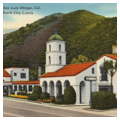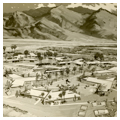In light of California’s cultural associations with the automobile, it is no wonder that the roadside motel emerged in the twentieth century as one of the state’s iconic architectural types. The appearance of the motel as a common element in the American vernacular landscape dates to the 1920s. While at first glance, the motel may seem to evolve directly out of the architectural genealogy of the hotel as a building type, in reality, the motel came from an entirely different impetus. The freedom and autonomy afforded by the car encouraged more and more American converts to auto touring as opposed to traveling by train. The automobile’s influence on the architecture of tourism is representative of widespread transformations of other types of commercial architecture as well, including department stores, supermarkets, and gas stations.
The work of cultural historian Warren James Belasco explores how the individualistic, anti-modern pursuit of autocamping in the late nineteenth and early twentieth centuries gave way to the motel, “a nationally standardized, up-to-date roadside business.” Whereas riding the train in the nineteenth century had evoked the industrial revolution, modernity, standardized time, and new ways of experiencing space and time, the automobile conjured up feelings of nostalgia and personal freedom and autonomy for the motorist. The development of motels, which originated in a reaction to overcrowded and overpriced hotels, reveals a gradual process toward consumerism based on individualism and comfort.
Motels were the product of a series of architectural adaptations beginning with auto camps, cabins, and cottage courts. What made these facilities so desirable to the earliest wave of auto tourists was the appeal of “convenience.” This term had been used in advertising to describe amenities at hotels as well; however, as automobility became a new American craze, convenience had come to hold a different meaning. Motels offered several conveniences: the ability to park the car right outside the cottage door, more privacy, no streetcar or city traffic noise, no tipping, no traffic congestion when arriving at the accommodation, no dress codes because of the lack of formal public spaces, and a speedy check-out system. The growing affinity toward these types of motel qualities set the pace for the rise of an American roadside cultural icon.
In the early 1920s, the demand by land owners to get auto tourists off of their land led to the creation of municipally owned auto camps that provided parking space and limited services to “autoists.” Around 1923, the cost of providing attractive grounds and services, such as water and kitchen facilities, and eventually cottages, prompted municipal auto camps to begin charging fees. Also, the desire of the more respectable auto tourists to get rid of the “riff-raff” or “tin can” tourists, encouraged the implementation of fees. Because of its year-round tourist season, the West Coast led the nation in both implementing fees and introducing shelter during rainy months. Some of the first privately owned auto camps developed in Los Angeles. These early auto camps prompted an evolutionary process that began with simple cabin camps and cottage courts and ended in standardized motels and, eventually, highway hotels.
Auto camps with space for cars and tents also provided rudimentary shelter in the form of cabins. Some cabin camps began to develop without even the precursory auto camp tents. After 1930, the term “cottage” began to replace “cabin” as the structures became more durable and suitable for colder months. These cottages usually contained private bathrooms, and some began featuring attached garages. Buildings were often arranged in rows, architecturally designed and furnished on the inside to resemble suburban houses. Motor courts, prevalent beginning in the 1940s, were much like cottage courts except that the units were completely integrated under a single roofline.
By the 1950s, motor inns or motels often featured a U- or L-shaped layout around a center courtyard, where landscaping and sometimes swimming pools were meant to evoke a resort quality. Located in downtown areas, near airports or major freeway interchanges, motor inns were two- or three-story buildings, usually with expanded public interior space such as coffee shops, dining rooms, or banquet halls. These motels could accommodate up to five times more guests on the same amount of land than the earlier model of auto camps, and with their center-core layout with rooms on both sides along a corridor, construction and heating/cooling costs were cheaper.
In general, large national motel chains were not economically feasible until the return of prosperity after World War II. So while the model of the Holiday Inn motel, in terms of physical layout and building type, was in existence as early as 1930, national chains of identical motel structures did not appear until 1945. However, California hosted a chain of establishments much earlier than postwar era. The Motor Inns of California appeared first in Los Angeles in 1921 with the construction of an automobile camp in Boyle Heights on Soto Boulevard and Stephenson Avenue.
A Los Angeles Times article from July 31, 1921 featured the new motor camp alongside a sketch of the complex. The article highlighted the aim of the Motor Inns of California, which was to provide accommodations specifically for motor travelers. For a dollar a night, guests would receive a room for two, a garage, and cooking quarters. The guest bungalows were situated on “spacious, parklike grounds, with each room an outside one.” The Times advertised the motor inn as “distinctly Californian” because of the outside rooms that opened “right into the sunshine and flowers.” This emphasis on the fluidity between interior and exterior space would continue to develop in motels throughout the state. This Californian quality also foreshadowed the similar defining characteristic of the California ranch house. Large picture windows, sliding glass doors, “outdoor room” patios, and eventually swimming pools, were all architectural elements mirrored in the motel typology.
The roadside motel soon appeared all over the country. Many notable examples flourished in California and the West, particularly along highways such as Historic Route 66. In 1925, architect Arthur S. Heineman designed the Milestone Mo-Tel on U.S. Highway 101 in San Luis Obispo. The Milestone is reportedly the first motel, though considering earlier examples of the auto court and motor inn, it is more accurate to say it was the first to use the term “motel” as designation. Heineman was an architect and real estate developer from Pasadena who modified the concept of the bungalow court, which had developed in his hometown, to the fit the needs of auto tourists along Highway 101. The motel featured six bungalows that could each accommodate four to five people. The building borrowed features of Mission or Spanish Colonial Revival architectural style, such as a tower and arcade reminiscent of the neighboring Mission San Luis Obispo, along with white stucco exteriors and red tile roofs.
Historic Route 66 also contains many extant examples of auto courts and motels dating to the 1920s and 1930s, including Albert’s Motel in Eagle Rock and the Paradise Motel on Sunset Boulevard. Other significant examples of California roadside motel architecture include the Heilman Villas (1922) in Coronado, Roy’s Motel and Café (1940s) in Amboy, the Wagon Wheel Motel and Restaurant (1947) in Oxnard, the Movie Land Motel (1952; now Vibe Hotel) in Hollywood, the Piedras Blancas Motel (1950s) near San Simeon, and the Madonna Inn (1958) in San Luis Obispo.
Within a few decades of its rise in popularity, the car had transformed the tourist experience. An article published in Hotel Monthly in 1930 confirmed this phenomenon and predicted some future impacts on the hotel industry. In 1919 the number of cars in America was 6,770,000; in 1928, this number had skyrocketed to 21,360,000. The number of trucks rose from 794,000 in 1919 to 3,120,000 in 1928. The number of travelers on the Santa Fe Railroad dropped from 15 million in 1922 to 4 million in 1928. The author of the article predicted some of the future effects of such transformations in travel:
Let us try to visualize the conditions which hotels will have to face in the coming auto and airplane age. The era of mass production of hotels rooms will cease and the mere size of the hotel will not be an attraction or much of a selling point in the future. Wide express highways will avoid congested areas, making the small hotel located at strategic points on these highways, popular. Such hotels will provide garage and auto facilities of all kinds. Airport hotels at the principle airports of the country will become an accomplished fact.
If the hotel industry wished to compete with the small “residential hotels” and motels located in decentralized areas of the city, it would have to conform to the growing demands of car culture. Even as the jet age opened up the market for more tourists to California, these tourists were still ultimately dependent on the automobile for traversing the city once they arrived.
References
Belasco, Warren James. Americans on the Road: From Autocamp to Motel, 1910-1945. Baltimore: Johns Hopkins University Press, 1979.
“Hotel Chain for Autoists.” Los Angeles Times, July 31, 1921.
Jakle, John A., Keith A. Sculle and Jefferson S. Rogers. The Motel in America. Baltimore: Johns Hopkins University Press, 1996.
Kendrick, Megan McLeod. “Stay in L.A.: Hotels and the Representation of Urban Public Space in Los Angeles, 1880s-1950s.” Ph.D. dissertation, University of Southern California, 2009.
Longstreth, Richard. The Drive-In, the Supermarket and the Transformation of Commercial Space in Los Angeles, 1914-1941. Cambridge: MIT Press, 2000.
Longstreth, Richard. City Center to Regional Mall: Architecture, the Automobile, and Retailing in Los Angeles, 1920-1950. Cambridge: MIT Press, 1997.
Meyer, R. L. “Future Trend in the Hotel Industry.” Hotel Monthly 38, no. 448 (1930): 82.
“Open First Motor Inn.” Los Angeles Times, December 4, 1921.
Sanborn Fire Insurance Maps, Los Angeles, 1909-1951, v. 14 1921-1949, sheet 1464.
Watters, Sam. “Milestone Mo-Tel, California’s first motel, was a Landmark Design.” Los Angeles Times, July 2, 2011.
Writing Credits
If SAH Archipedia has been useful to you, please consider supporting it.
SAH Archipedia tells the story of the United States through its buildings, landscapes, and cities. This freely available resource empowers the public with authoritative knowledge that deepens their understanding and appreciation of the built environment. But the Society of Architectural Historians, which created SAH Archipedia with University of Virginia Press, needs your support to maintain the high-caliber research, writing, photography, cartography, editing, design, and programming that make SAH Archipedia a trusted online resource available to all who value the history of place, heritage tourism, and learning.



